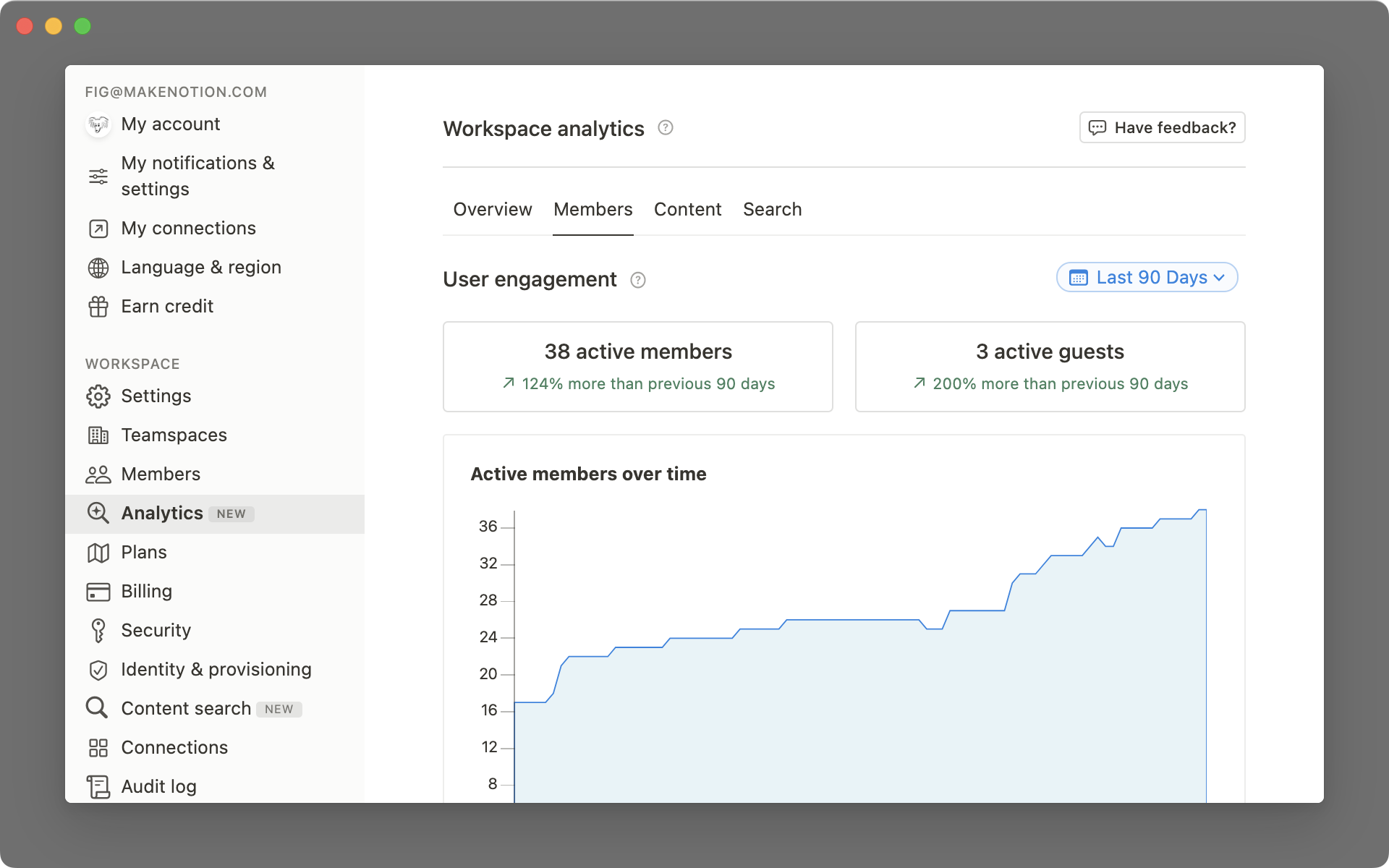Get useful insights with workspace and page analytics
Notion analytics provides insights into how your team members and collaborators interact with Notion, at both page and workspace level. See how people engage with individual pages and the workspace as a whole.

- Page Analytics tell you who’s viewed and edited your page
- Get a deeper understanding of how teams use Notion with Workspace Analytics
Analytics can help all workspace contributors - from page creators to knowledge managers - make information more useful and accessible in Notion.
If you create, maintain or update knowledge in the workspace, you can get helpful insights into how your content is received. So, you can check who’s read the latest version of a feature spec, discover topics of interest within your organization, and identify the Notion champions who are best placed to train other users, and more.
In this guide, we’ll show you where to find analytics data and use it to boost engagement with content and adoption of Notion in general.
Page Analytics tell you who’s viewed and edited your page
As a workspace member, you can view page analytics for any page you have editing access to.
To open page analytics, go to the 🕘 View all updates icon at the top right of the page, which will open a sidebar on the right-hand side. Click on the Analytics tab.
Here, you’ll be able to see:
The total and unique page views — The Views graph will show you how times the page has been viewed and when, plus the number of unique views. If your page is shared to the web, online views will also be counted.
Who viewed the page — Under Viewers, there’ll be a list of people who’ve viewed the page, and when they last viewed it. This list won’t include anonymous viewers who aren’t members or guests, but have seen your page online.
Creator and editors of the page (Business and Enterprise Plans only) — See who first created the page, and when, as well as a list of everyone who has subsequently edited the page.
This data is useful if you want to make sure everyone has seen the latest version of a doc. A product manager, for example, might want to check page analytics to ensure that everyone on the team has seen the Product Requirement Doc (PRD) since the latest changes. Similarly, an HR manager might need to check who has read the updated benefits policy and decide whether to send another email reminding people to review it.
Page analytics can also give you an overview of how a document or database has evolved over time. You can see who has contributed to the information and when certain changes were made
This not only helps you understand how up-to-date the doc is - it also means you can reach out to whoever last edited the page if you have any questions about the information.
Get a deeper understanding of how teams use Notion with Workspace Analytics
IT managers and those responsible for building and maintaining the company knowledge base need to understand the effectiveness of the Notion workspace and how to make it easier and faster to access knowledge, share information, and connect with colleagues.
Workspace analytics help you do this.
Organizations on Notion’s Enterprise plan can use Workspace analytics.
- Content analytics are available to all Members of the workspace for the pages they have edit access to.
- Workspace owners also have access to Search and Member analytics.
To open workspace analytics, go to ⚙️ Settings & members in the top left corner. Then, click Analytics, which is located under Workspace.
Workspace analytics are organized into three categories: Members, Content and Search. You can also view a combination of key data in the Overview tab.
Here are some ways you might use each category of workspace analytics:
Understand how well your team members are adopting Notion — In the
Memberstab, workspace owners can see which teamspaces each member belongs to, how many pages they’ve viewed over a certain time period, how many edits they’ve made over that time period and the date of their most recent activity. From here, you can spot your power users and identify less active members who might need extra support or training.Track how people engage with content — In the
Contenttab, workspace members can track engagement with metrics like number of views, unique viewers, and last edited date. With this data you can identify popular pages and outdated content. All your pages will be displayed in a table, along with the teamspace they belong to, the page audience, total views, unique views, total views, and the last edited date. You can filter the table by time period to see, for example, activity over the last 7 days or the current month.See what team members are searching for — Workspace owners can view what members are searching for in the
Searchtab. Here, metrics like Number of searches, Number of unique members searching, and click-through rate can help you detect content gaps (for example, if people are searching for a doc that doesn’t exist yet). You can also update and refresh content to ensure it’s meeting the needs of your users and providing sufficient knowledge.
Workspace analytics are a key piece of the puzzle that can tell you how people at your organization are using Notion, and there are various ways to use that information. If you want to do a more in-depth analysis or create charts based on your data, you can export your data as a CSV file.
Your most active team members who frequently create and edit pages are likely to be power users who are very comfortable with Notion. These team members could become champions of your workspace best practices, and even provide training to your least active users who need extra support. You can find these power users by looking at the All members table and seeing who is most active.
Knowledge managers can use workspace analytics to decide what new content to create, and set priorities for which documents to create update next. In the Content tab, you can sort pages by their popularity to show most-viewed pages first. Then, scroll to right to see the last-edited date. If an often-viewed document hasn’t been edited for a few months, you may want to mark that as priority to review and refresh.
Something we didn't cover?








